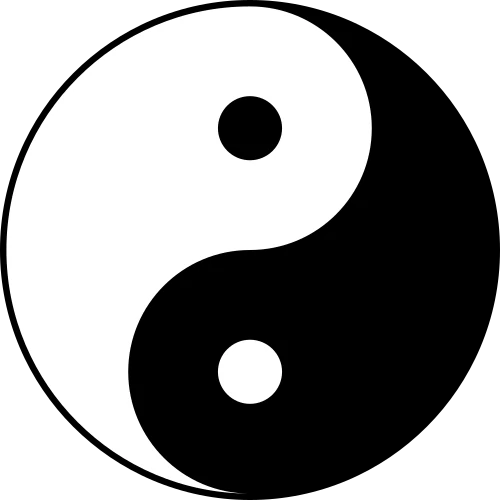Taoist Yin Yang symbol
The Yin and Yang principles act on one another, affect one another and keep one another in place.
– Chuang Tzu
For 2500 years, the Taoist principle of Yin Yang has been depicted in a familiar circular symbol known throughout the world. It is worn on bracelets, appears on clothing, and is used in corporate logos. This symbol represents core Taoist principles, with some interesting nuances, which are central to its philosophy.
Since Taoism’s philosophical and religious system is built on a holistic view of reality, its Yin Yang symbol is foremost a representation of Universal Oneness with black and white colors alternating within a single circle. Thus the duality of all phenomena — whether summer and winter, male and female, or life and death — are shown to be opposing manifestations of the same principle and should not to be viewed as independent phenomena. This depiction of Oneness and its Opposites are integral to understanding all of Lao Tzu’s poetry.
The Yin Yang symbol is half white and half black, each side representing a polar opposite. Note, too, that the symbol is neither predominately white nor predominately black, but equal portions of each. This is meant to represent the balanced proportions of our universe as found in nature. For example, both day and night are needed in roughly equal proportions for life on earth to thrive — 24 hours of daylight or 24 hours of darkness would be disastrous. The symbol also exhibits a rotating pattern between the two colors, suggesting a continuous exchange or movement from black to white and from white to black, like day to night and night to day. These natural manifestations of the Yin Yang principle illustrate how opposites must balance for harmony to be achieved. In Chinese medicine, the balance of Yin Yang forces is the most important of healing principles.
Understanding Yin and Yang forces is essential to successfully building one’s path through life. For example, the Yin Yang symbol has a definite line between the white and black areas; a well-defined contour distinguishing the two colors. This clarity of color symbolizes the need for clarity in all aspects of a life. Gray isn’t found in the Yin Yang symbol. Clarity requires one to commit to do nothing halfway; or to paraphrase an old adage, one shouldn’t try to sit on two chairs. In becoming a spiritual person, a clear purposeful understanding of what is happening is required to determine appropriate action. Caution is required when black and white mix to form an uncertain gray. Unfortunately, confusion will invariably arise when presented with new situations during the course of life. Periods of confusion can be expected, much in the same way that each day transitions through twilight into night. It is the goal of the Taoist, however, to keep his twilight — his period of confusion — as short as possible. As in nature, twilight does not last 24 hours.
Some people seem to embrace confusion, chasing the twilight. They fear decision-making because it carries responsibility for action. For these people, the line between yin and yang is blurred as they remain passive in ambiguous periods. Taoism’s strategy, instead, is to gain clarity and not stay in the middle. Sometimes this can be hard as decisions to achieve clarity may involve uncomfortable conversations followed by tough action. For example, not confronting a dysfunctional and unclear relationship — both personal and professional — comes to mind.
It is equally important to distinguish clarity from purity. A clear vision of the world and decisive navigation throughout life should not be based upon unrealistic expectations of purity. The futility of searching for absolute purity is illustrated by the small white dot in the black area and the small black dot in the white area of the Yin Yang symbol. For example, one has no trouble distinguishing day from night, and yet there is not pure darkness at night — there is still some light from the moon and stars. Similarly, when an accomplished artist paints a tree leaf, he mixes in a little brown and yellow paint with the green to achieve a natural, lifelike appearance; a child painting the same leaf would use pure green, which appears artificial and unnatural.
Embracing the power of opposites is necessary for most phenomena to function correctly. An athlete knows muscles grow only if intense physical training is followed by a period of relaxation — otherwise over-training results in damaged muscles. A military officer cultivates tactics for aggressive attack, but also understands how to retreat. Lao Tzu emphasized this inclusion of a small component of opposites, warning that the male part of any phenomenon should “embrace the female.” Thus a natural path does not seek unrealistic purity, but rather a harmony of opposites. If only history’s fanatics understood such a concept!
So with the philosophy of the Yin Yang symbol understood, how can it be applied? Given the unity of Taoism, there are applications in the physical, mental and metaphysical realms.
The Yin Yang symbol is a circle and not a square; there are no straight lines in nature. In fact, any dynamic motion is more efficient when following a trajectory similar to the Yin Yang contour. Thus, the physical motions used in Tai Chi and Chi Quong are circular and not straight in order to better accelerate the body’s natural energies. Martial artists develop increased power by using yin/yang circular motions that are anatomically correct and optimal accelerators.
In the intellectual realm, the Yin Yang symbol offers a valuable tool for sorting out life’s priorities and making difficult decisions. It turns out that it’s easier for the mind to comprehend what is not wanted, rather than what is desired. For example, if asked what a person wants out of life, there is often confusion and bewilderment. However, by mentally exploring what is not wanted, the desired aspects become clearer and clearer. It turns out that investigating the opposite side of any phenomenon often provides an easier path to enlightenment than the more direct approach. This is a valuable technique that can be immediately used without specialized training.
Death haunts us. Its inevitability is one of the most important driving forces in life. Its uncontrollable arrival is feared and the loss of loved ones lamented. However, the Yin Yang symbol illustrates a profound philosophical view that provides comfort. It turns out that the symbol’s rotation of colors represents the journey of the soul and prompts this question: If you fear what happens to your soul after it departs the dead body, shouldn’t you wonder where it came from when it entered the body? That is, the soul goes somewhere at the time of death, so it came from somewhere at time of birth. The realization that death is that time when the soul returns to its home is reassuring. It also carries profound implications about the purpose of life.
Symbols are important: countries have flags, companies have logos, and religions have icons. Taoism’s Yin Yang symbol is remarkable because it represents the faith’s cornerstone principles for immediate application in handling life’s big challenges. Indeed, for Taoists, this symbol is its Rosetta Stone.

